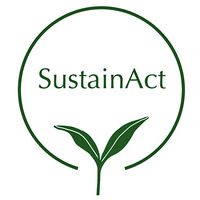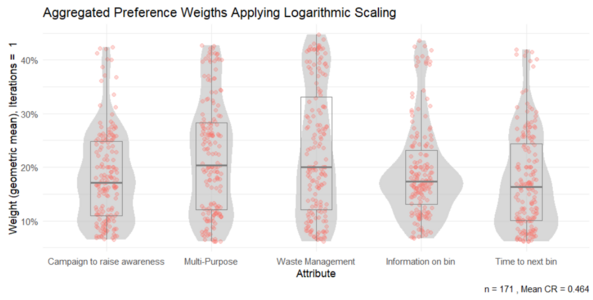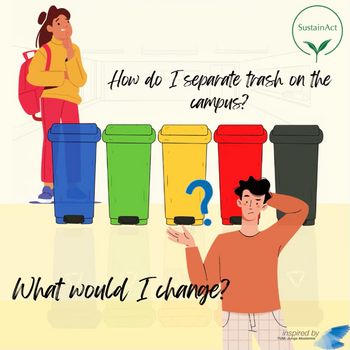SustainAct
About Our Project

Waste management is not uniform across TUM. This shows in a varying availability of trash bins, which allow for sorting. While some offices are equipped with trash bins for paper and one mixed bin, there are several offices with mixed-purpose trash bins only. Similar observations can be drawn from public spaces. Campus buildings are mostly equipped with mixed-purpose bins, while multi-purpose bins are rare.
A lack of multi-purpose bins can also be observed at the WZW Campus in Freising. A new waste management strategy was implemented at WZW in the year 2019. New trash bins were supposed to allow for waste separation. So called “Müllinseln”, spots for centralized trash collection, were therefore installed across the campus. Public spaces and offices do still seem to lack possibilities for waste separation. Trash separation is therefore mainly possible at the “Müllinseln”.
The shortcomings in the availability of trash bins, which allow for separation of trash, has drawn the attention of TUMs Green Offices. Campaigns, which aim at improving waste separation, are planned for the year 2023.
Our Research Questions
There seems to be a large variability in the availability of trash bins, which allow for waste separation across TUM. Our first research question aims at the current status quo of waste separation at TUM.
-
To what degree is waste separated at different TUM campuses?
The first research question can be an indication for the demand for improved waste separation possibilities.
Interventions at various TUM campuses are planned to improve waste separation. Our second research question aims at different improvement strategies and their benefits.
- Which measures should be introduced to improve waste separation?
Methodology
The research questions are tackled via a quantitative survey. TUM students and employees of different campuses and research areas are surveyed. The survey follows the analytic hierarchy process (AHP) framework to reveal the relative preference for different benefits of a campaign on trash segregation. The compositional data is analysed by compositional data analysis. Regressions was run to determine factors that explain the relative importance of different benefits.
Results
Our survey highlighted the discrepancy between acceptance of waste separation behavior and actual behavior across various TUM campuses. We find that TUM members are willing to separate waste, but are not able to do so to a large extent. This is most likely due to the lack of multi-purpose trash bins. Unfortunately, only mixed bins, and for a large part also paper bins, are available in everyday campus life. TUM members are furthermore not aware of TUM-wide waste bin color schemes.
While some differences between campuses exist, especially regarding the acceptance of different waste improvement measures, there seems to be a general lack of multi-purpose waste bins across all campuses. The so called “Wertstoffinseln” are not working and should be reconsidered if increased waste separation at TUM was their main motivation.
Better collection of separated waste turned out to be the most requested measure, indicating a lack of trust in the current waste management system. We also observe that information and awareness campaigns are of lower importance in general, but also on the level of campuses (Straubing) or Schools (Engineering and Management).
A high acceptance of the practice of waste separation among TUM members was revealed. Some members are even separating waste if the respective bins are not present, or if there is a suspicion that waste is mixed during collection. We argue that waste separation is not an information or cultural problem, but an issue of management. Information campaigns would likely be of low effect, especially as long as the number of multi-purpose bins does not increase. Be it the working space, hallways or open spaces, the next convenient bin is the one most likely to be used. We further argue that the second most important measure, after the provision of multi-purpose instead of mixed bins, would be an improvement in waste collection. Waste separation has to be a standard for all sub-contracting firms. Communicating how waste is disposed of in a separated form would further help to build trust between TUM members and subcontractors.
Mere information campaigns on how to separate waste, or on the importance of waste separation, do not hold much promise; low acceptance of waste separation is a problem from the past. The encouraging message is that this is not a people’s problem, but a problem of management and infrastructure.

Team Members
- Aastha Chandiwala
- Moritz Ptacek
- Corinna Winkler

Tutors
- Rodrigo de Rojas
- Veronika A. Bauer

Contact Us
sustainact@ja.tum.de
